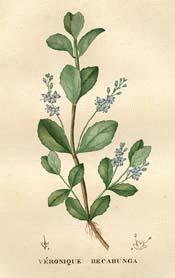

|
Brooklime
(Veronica beccabunga)
|
Brooklime
Botanical: Veronica beccabunga (LINN.)
Family: N.O. Scrophulariaceae
---Synonyms---Water Pimpernel. Becky Leaves. Cow Cress. Horse Cress. Housewell. Grass. Limewort. Brooklembe. Limpwort. Wall-ink. Water-Pumpy. Well-ink.
---Part Used---Herb.
---Habitat---Brooklime is found in all parts of Great Britain, being very common and generally distributed, occurring as far north as the Shetlands, and in the Highlands ascending up to 2,800 feet. It is found in Ireland and the Channel Islands.
---Description---It grows abundantly in shallow streams, ditches, the margins of ponds, etc., flourishing in the same situations as Water Cress and Water Mint, throwing out stout, succulent, hollow stems that root and creep along the ground at the base, giving off roots at intervals, and then ascend, bearing pairs of short, stalked, oval-oblong leaves, smooth, about 1 1/2 inch long, slightly toothed on their margin and thick and leathery in texture. The whole plant is very smooth and shiny in appearance, turning blackish in drying. The flowers are rather numerous, in lax, axillary racemes, 2 to 4 inches long, given off in pairs, whereas in Germander, Speedwell, only one flower stem rises from each pair of leaves. They begin to open in May and continue in succession through the greater part of the summer, though are at their best in May and June. The corollas are bright blue, with darker veins and a white eye, the petals oval and unequal. Occasionally a pink form is found.
The flower is adapted for cross-fertilization in the same manner as Veronica chamaedrys, the stamens and style projecting from the flower and forming an alighting place for insects. The petals are wide open in the sun but only partly expanded in dull weather. The flowers are much visited by insects, especially by a fly, Syritta pipians. The Honey Bee is also a visitor and some other small wild bees. Two species of beetle and the larva of a moth, Athalia annulata, feed on the leaves. The capsule is round, flat notched and swollen and contains winged, smooth seeds.
The specific name of this plant seems to be derived from the German name, Bachbunge bach, signifying a brook, and bunge, a bunch. Another source given for the specific name is from the Flemish beckpunge meaning 'mouth smart,' a name suggested by the pungency of its leaves, which were formerly eaten in salads. Dr. Prior tells us that the name Brooklime is in old writers Broklempe or Lympe, from its growing in the lime or mud of brooks, the Anglo-Saxon word lime, coming from the Latin limus, a word that from mud used in the rude buildings of Anglo-Saxon times, has come to be applied to the calcareous stone of which mortar is now made.
[Top]
---Constituents---Tannin and a special bitter principle, a pungent volatile oil and some sulphur.
---Medicinal Action and Uses---Alterative, Diuretic. The leaves and young stems were once in favour as an antiscorbutic, and even now the young shoots are sometimes eaten in spring with those of Watercress, the two plants being generally found growing together. As a green vegetable, Brooklime isalso wholesome, but not very palatable.
In earlier days the leaves were applied to wounds, though their styptic qualities appear to be slight. They are sometimes bruised and put on burns.
The juice, with that of scurvy-grass and Seville oranges, formed the 'spring juices' once valued as an antiscorbutic.
The plant has always been a popular simple for scrofulous affections, especially of the skin. An infusion of the leaves is recommended for impurity of the blood, an ounce of them being infused in a pint of boiling water.
In the fourteenth century, Brooklime was used for many complaints, including swellings, gout, etc.
[Top]
Common Name Index
A MODERN HERBAL Home Page
Bear in mind "A Modern Herbal" was written with the conventional wisdom of the early 1900's. This should be taken into account as some of the information may now be considered inaccurate, or not in accordance with modern medicine.
© Copyright Protected 1995-2004 botanical.com

|



